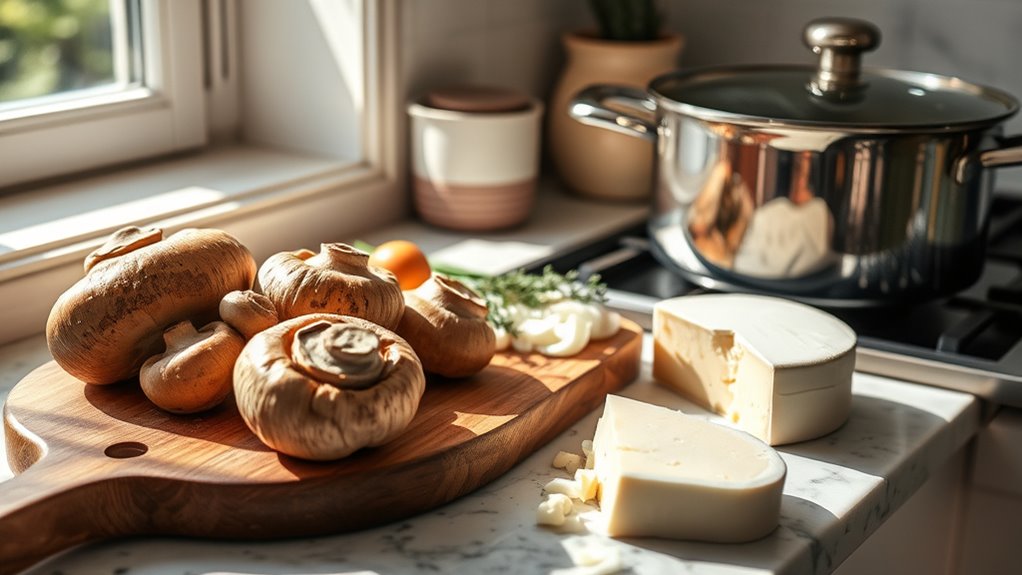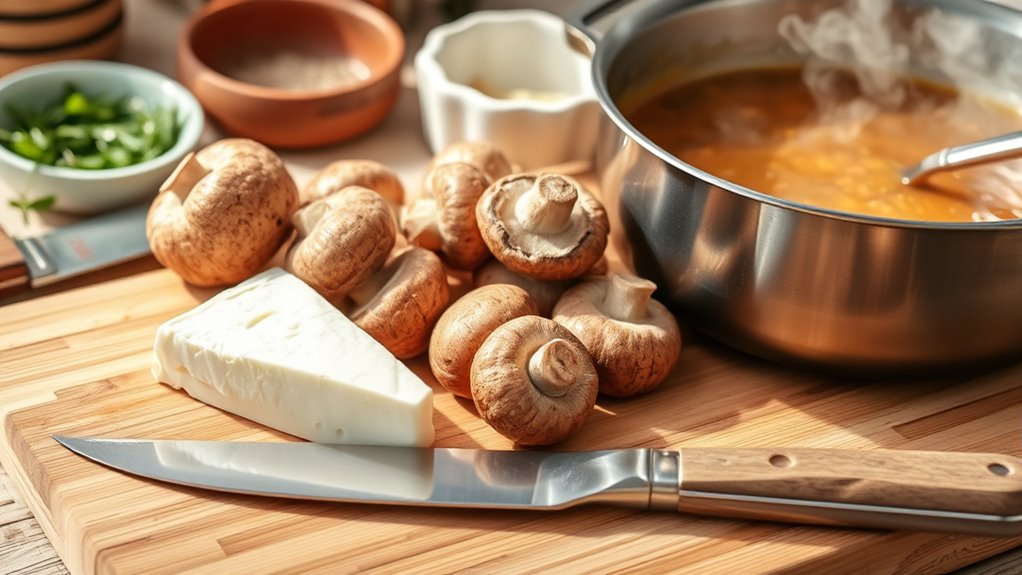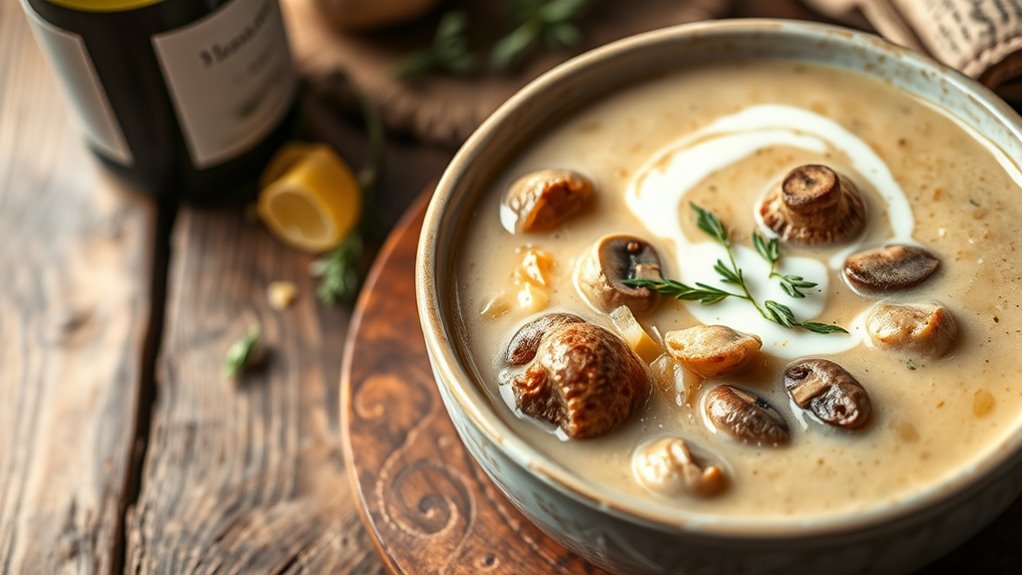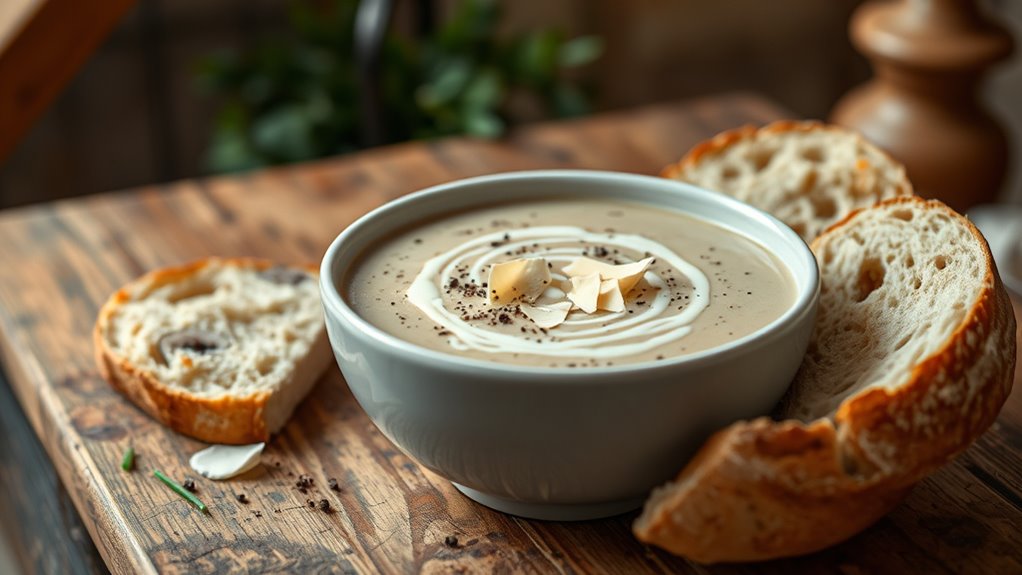This creamy Brie and mushroom soup starts with sautéed mushrooms in butter, building depth as you deglaze with white wine or broth. You’ll stir in Brie for a luxurious, silky texture, then add vegetable stock and cream to finish. Season with garlic, thyme, salt, and pepper, and simmer until smooth. Serve with crackly bread and a drizzle of cream, topped with Brie shavings. Want more tips and exact steps to perfect it? Continue on to discover more.
Ingredients and Quantity

Here are the ingredients and their quantities for the Brie and Mushroom Soup: You’ll craft a bold base with freedom in mind. Choose Brie varieties that melt smoothly, and select Mushroom types that balance earthiness with brightness. You’ll need 2 cups white wine, 4 cups vegetable broth, 1 cup cream, 2 tablespoons butter, 1 small onion, 2 cloves garlic, 8 ounces mushrooms, sliced, 8 ounces Brie, rind removed, cubed, salt and pepper to taste, and fresh thyme for aroma.
| Ingredient | Quantity |
|---|---|
| Brie varieties | 8 oz, cubed |
| Mushroom types | 8 oz, sliced |
| Onion | 1 small |
| Garlic | 2 cloves |
| Cream | 1 cup |
Preparations

To prep, start by warming a tablespoon of the butter in a large pot over medium heat. You’ll hear a soft sizzle as the fat coats the surface, signaling steady heat. Add sliced mushrooms and a pinch of salt, sautéing until their edges brown and juices evaporate. This moment honors preparation techniques: deglaze with a splash of white wine or broth, scraping any browned bits to build depth. Move on to aromatics—garlic, shallot, thyme—cooking just until fragrant. For ingredient selection, choose firm, evenly sized mushrooms and fresh, unsalted butter. Keep the pace calm and controlled, avoiding overcrowding. Stirring consistently yields a silky base, ready for stock and Brie. Your discipline here shapes texture, flavor, and the soup’s final richness.
Kitchen tools or Kitchenware Required

Gather the right kitchen tools to keep the simmering process smooth and steady. You’ll want a sturdy soup pot, a sharp knife, a cutting board, and a wooden spoon. An immersion blender is essential for a silky texture without ladling hot soup. A ladle, measuring cups, and a whisk round out the basics, while a heat-safe lid helps control temperature. Choose tools with comfortable grips for ongoing stirring and tasting. Table below highlights a key setup concept:
| Tool | Purpose | Benefit |
|---|---|---|
| Soup pot | Base for simmering | Even heat distribution |
| Immersion blender | Smooth texture | Quick, controlled blending |
| Wooden spoon | Stirring | Gentle surface, prevents scratching |
How to Cook

- Sauté onions and garlic in butter or olive oil until translucent and fragrant.
- Add mushrooms and cook until they release moisture and begin to brown.
- Season with salt and pepper to deepen the flavor base.
- Deglaze the pan with a splash of white wine or broth, scraping up the fond to capture flavor.
- Add Brie, either in chunks or with the rind removed, allowing it to melt into the simmering liquid for creaminess.
- Stir in vegetable or chicken stock and bring to a gentle simmer.
- Adjust the soup’s thickness by adding more stock or a splash of cream as needed.
- Maintain a steady simmer (avoid boiling) to preserve the soup’s texture.
- Taste and adjust seasoning for balance; refine with fresh herbs if desired.
- Focus on cooking techniques and flavor profiles to craft a balanced, comforting soup.
How to Serve

When you’re ready to serve, ladle the soup into warm bowls and crown each portion with a few shavings of Brie or a delicate drizzle of cream for extra richness. You’ll notice aromatics linger—earthy mushrooms, a hint of thyme—adding depth to every first bite. Keep the bowls warm to preserve the velvety texture as you present. For garnish options, consider a light dusting of cracked black pepper, a final drizzle of olive oil, or a small sprig of fresh herbs like chives or parsley to add color. Serving suggestions emphasize balance: pair with crusty bread or a delicate salad to complement the richness without crowding flavors. Present confidently, inviting guests to savor each spoonful and the comforting aroma.
Tips
To make Brie and Mushroom Soup shine, start with smart prep and practical tweaks that boost flavor and texture. You’ll gain depth by sautéing mushrooms until deeply caramelized, then deglazing with white wine to lift browned bits. Use a light touch with the Brie, folding it in gently so it melts smoothly without clumping. For a silkier finish, finish with a splash of cream just before serving and season boldly, not timidly. Garnishing techniques matter: a drizzle of truffle oil, a few sautéed mushroom coins, and a chive or parsley scatter add color and aroma. If you need substitutions, consider gruyère or parmesan for a different bite, or swap dairy for a dairy-free cream alternative. Ingredient substitutions keep the soup flexible without losing soul.
Food Value and Benefit
Brie and mushroom soup offers a nutritious and comforting meal packed into a single bowl. This dish combines creamy textures with the earthy flavor of mushrooms, providing a satisfying and energizing experience.
Food Value:
- Rich in protein from brie cheese and mushrooms, supporting muscle and tissue maintenance.
- Contains essential minerals such as calcium and phosphorus, which promote strong bone health.
- Provides potassium to help maintain proper fluid balance in the body.
- Contains B vitamins that aid in metabolism and support mood regulation.
- Low in fat while delivering rich and satisfying flavor.
Benefits of Eating Brie and Mushroom Soup:
- Supports bone strength and dental health through calcium and phosphorus content.
- Helps maintain energy levels and satiety with steady protein supply.
- Promotes healthy metabolism and emotional well-being thanks to B vitamins.
- Assists in fluid balance and muscle function due to potassium.
- Easy to digest and gentle on the gut, making it suitable for sensitive stomachs.
- Encourages mindful eating with simple, high-quality ingredients prepared thoughtfully.
Enjoy this nourishing soup as a delicious way to fuel your body while supporting overall health and wellness.
Frequently Asked Questions
Can I Substitute Dairy-Free Cheese in This Soup?
Yes, you can; try dairy-free options like cashew cream or coconut milk, then adjust salt and acidity to taste. These choices preserve texture and flavor profiles, giving you creamy richness while aligning with dairy-free preferences and cooking freedom.
What Is the Best Mushroom Variety for Depth?
You’ll get depth best with shiitake mushrooms and portobello flavor, adding umami and body. You should sear them well, then simmer to concentrate their richness, letting their earthy notes elevate the soup for a balanced, freedom-loving finish.
How Long Can Leftovers Stay Safely Refrigerated?
Leftovers stay safely refrigerated for 3 to 4 days. For best food safety, store promptly in airtight containers, label dates, and reheat to steaming hot before enjoying. Trust your senses, but don’t risk unsafe leftovers.
Can I Freeze the Soup for Later?
Yes, you can freeze it. For best results, use airtight storage containers and leave room for expansion. Freezing tips: cool completely, label, and date. Thaw in fridge overnight, then reheat gently, stirring to avoid separation.
Is There a Vegan Alternative for the Roux?
Yes, you can use vegan roux options like gluten-free flour, oat flour, or almond flour whisked with plant-based fat. Also try plant based thickeners such as pureed cashews, coconut cream, or arrowroot for creamy texture.
